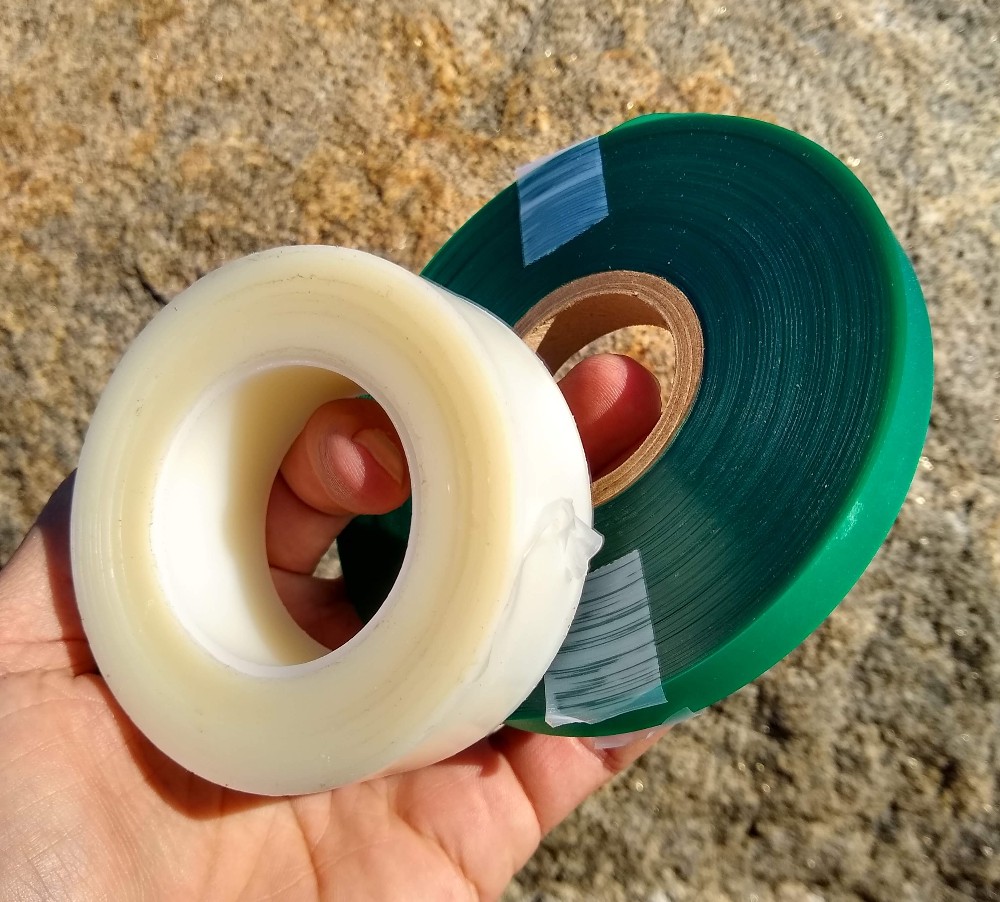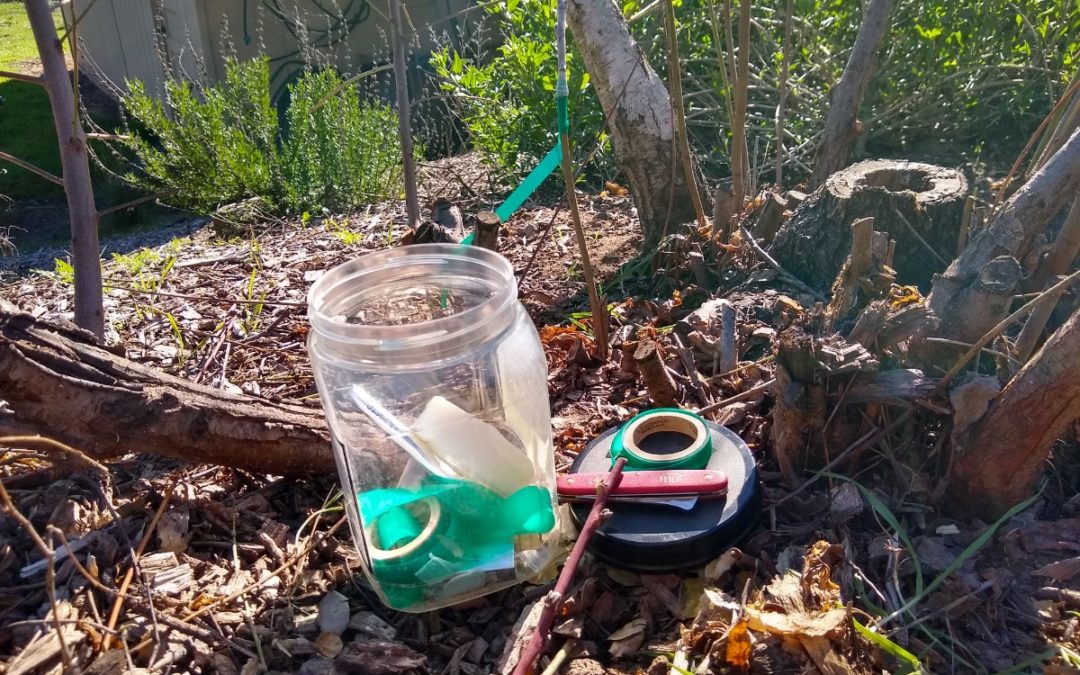There are excellent documents, videos, and books that can help you successfully graft deciduous fruit trees in the winter in Southern California. Directing you toward those is the main aim of this post. Secondarily, I’ll note a few of my own preferences and tips.
Before getting to the resources, let’s remember why we graft deciduous fruit trees. You might want to add a pollenizer branch. (See more about this in my post “Grafting a pollenizer branch into your fruit tree.”) Or your friend might have a tree that makes delicious pears; grab a branch and graft it onto your pear tree.
You might want to make a tree that has multiple varieties in order to save space. For example, I have a Snow Queen nectarine tree that I grafted Red Baron peach into. About two-thirds of the canopy is Red Baron peach. So with this single tree we get nectarines in June and then peaches in July.
You might want to renew an old tree by grafting onto rootstock suckers. I did this with an old peach whose trunk was diseased. I’ve ended up using the rootstock suckers to try out many varieties of peach and nectarine.

And on and on. Grafting can be used in myriad other ways. Only your creativity is the limit.
Videos about grafting deciduous fruit trees in winter
So who can help us graft with success? With the advent of YouTube, there are endless videos showing grafting, but here are a few that I find useful, particularly for grafting deciduous fruit trees, in winter, and in Southern California.
“How to Collect and Prepare Grafting Wood for Fruit Trees” by Mike Pace of Utah State University Extension. I’ve never bothered soaking my scions in a chlorox solution as Pace shows, but maybe that’s a wise safeguard.
“Selecting the Right Graft” by Kevin Hauser of Kuffel Creek Apple Nursery in Riverside. In winter, you want to choose the cleft, chip bud, or whip grafts that Hauser shows.
“Grafting Fruit Trees” by Tom Spellman of Dave Wilson Nursery demonstrates a few methods you can use on deciduous fruit trees in winter, including cleft, whip and tongue, and side veneer grafts.
Note that these grafting methods can also be used on individual branches of large trees, not just the small trunks of young trees. And instead of the rubber bands and asphalt seal that Spellman uses, you can also use different types of tape to hold the graft and seal in moisture.
Slideshow presentation on grafting deciduous fruit trees
It is sad that we have lost the treasure of Chuck Ingels, who passed away a few summers ago, but fortunately he left a few very reliable resources on grafting deciduous fruit trees that we can still access. One is his slideshow presentation called “Budding and Grafting.”
Budding and Grafting by Chuck Ingels.
Book on grafting deciduous fruit trees
Also, in The Home Orchard, the best book about growing deciduous fruit trees in California generally (see my review here), Ingels has a great chapter on grafting. It is full of photos, drawings, and clear descriptions.
The book is worth buying for every one of its chapters, but if you’d just like to check out its chapter on grafting you might see if you can borrow it from a library.
Personal preferences and tips
I am not a professional grafter; I’m a mediocre amateur. But this might make me well qualified to share a few preferences and tips to other beginners or amateurs since I’m less likely to make assumptions or talk over anyone’s head.
Timing
In terms of collecting scion wood, I’ve done so mostly in January. Almost all varieties everywhere in Southern California are dormant in early January. In late January, early varieties can already be blooming which means it’s too late. For example, here on January 31, 2020 my Eva’s Pride, May Pride, and Tropic Snow peaches are already pushing popcorn blossoms. Friends with Flordaprince peaches already have open blooms.
I’ve done the actual grafting in January, too. But sometimes I keep the scion wood in the fridge for a few weeks and do the grafting as late as mid February. The scion wood needs to be dormant, but it’s acceptable if the stock tree or branch is beginning to grow.
Methods
In winter, I have mostly used whip grafts. Sometimes I add a tongue to my whip grafts, but often I don’t bother. Last winter I did dozens of whip grafts and the only one that didn’t take was one that I did upside down! Somehow I’d put the scion on with the buds pointing the wrong way. The point is that I’ve found a simple whip graft to be very effective in winter.

Tools and materials
I did my first grafts some years ago with a pocket knife and a plastic bag that I’d torn into strips, and I had some success. You don’t need fancy tools and materials to graft. In fact, veteran grafters all have different preferences for tools and materials.
That being said, you might like to know that the knife I use and like for grafting deciduous fruit trees in winter is this Felco Victorinox Budding and Grafting knife:

More important than the specific knife is how sharp it is, however, which is why I included my Felco sharpening tool in the photo.
And I like to use one-inch-wide Parafilm tape (clear) and half-inch tape (green) for tying and covering grafts. Every good nursery carries these.

Good tools and materials do make the job easier. If you’re just trying your hand at grafting though, don’t think you need to buy a bunch of stuff from the outset. Rather, with whatever tools and materials you have on hand, do many grafts so the chances of a few succeeding rise.
That’s probably the best advice I ever got about grafting: It’s a numbers game. Even professionals don’t get 100% take so do more than you need.
That graft that I did upside down last winter? Wasn’t a problem because I’d done a second graft of the same variety, this one right side up. And it took.
Read more Yard Posts here.




My friend want to give me grafted pomegranate plant now.
I am in southern Calufornia-Wilmington-Los Angeles.
Can i grow this grafted plant in winter season?
What important care should i take throughout winter season?
Hi Chetan,
Pomegranates are fruiting now but they’re about done growing for the year. Soon their leaves will be turning yellow and dropping.
Pomegranates are tough. It’s actually hard to kill them. I don’t think you’ll have to do anything for a new little tree except make sure its roots don’t totally dry out.
Hi Greg, do you have any experience with citrus tree grafting? I have ordered some Shiranui budwood from CCCP this week. But from I have read so far it’s too cold to do citrus grafting in January in SoCal. Do you know when would be a good time and what method would be more effective since citrus is evergreen? I like the simplicity of whip graft and am intimidated by other methods like bud or T-bud (the budwood I’ve received is very thin), but just don’t know if these budwood I have now in the fridge will still be good for whip graft if I wait till April/May.
Hi Jing,
I only have a little experience grafting citrus. I’ve only done it outside of winter; for example, last year I grafted Shiranui in April. But I’ve been told by a nurseryman that you can graft citrus all year long. Also, some of my citrus are already beginning to grow here in January.
As to the method, I’ve done T-budding and whip grafts and had about the same success rate on each. At first I was also intimidated by T-budding, but with the skinny sticks you get from CCPP it’s also painstaking to do whip grafts. At least with T-budding you only use a single bud with each attempt. The Fruitmentor videos are helpful: https://www.youtube.com/c/Fruitmentor/playlists
The budwood lasts surprisingly long in the fridge. If you just keep it in the plastic bags in the crisper drawer, it will last a couple months. If you wrap the sticks in parafilm and put them back into the plastic bags, I’ve found that they’ll last even longer.
You might try doing a couple grafts now and then waiting a month or two to do the rest. Best of luck!
Thank you so much for the quick response and detailed information provided. Really appreciate you sharing your tried-and-true knowledge, I trust your “Yard Post” so much that it’s my first go-to source whenever I have questions.
Thanks for the feedback, Jing. I really appreciate it. Hope you get some great Shiranui fruit in your yard in the near future.
Hi Greg,
I learned from a master gardener presentation that cherry trees in California should be pruned in late summer and not in our wet winters to avoid eutypa dieback.
So I’d like to know (a) when do you prune your cherry trees (b) when do you graft them? Thanks.
Hi Deb,
I’ve also read that it’s safer to prune both apricots and cherries (and even apples) in late summer to avoid Eutypa dieback, caused by the fungus Eutypa lata. While I do prune all of these trees in the late summer, I also prune them as necessary in the winter. With these and all trees, I try to prune during a forecasted dry spell in winter to mitigate this type of risk. I also try to graft during such a dry spell.
I haven’t seen Eutypa dieback on any of my trees so far. I don’t know how lucky I am or whether it’s just not a big concern in my particular location compared to other locations.
Hello Greg,
Thanks for your reply. From all I have read, it seems to me that Eutypa is more of a problem in Northern California than SoCal. I’ll try grafting next year taking extra precautions to prevent water from getting into the graft and keeping my fingers crossed.
Good luck on all your grafting experiments!!